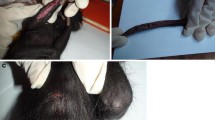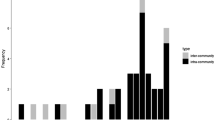Abstract
In nonhuman primates, infanticide by adult males can occur when the leader male is ousted from a one-male, multifemale group, or when male dominance rank changes within a multimale, multifemale group. According to the sexual selection hypothesis, this behavior may be adaptive if perpetrators increase their reproductive success by killing unrelated, unweaned infants, thus shortening the interbirth interval of the mother, and then siring her next infant. Under an alternative hypothesis, infanticide is a byproduct of aggressive male–male competition and these predictions do not hold. Direct observations of the context surrounding infanticide in free-ranging primate populations that allow a test of these predictions are rare. Here, we document four cases of male infanticide and report paternity data for a group of golden snub-nosed monkeys (Rhinopithecus roxellana) at Shennongjia, China. Three cases of infanticide by new leader males supported the predictions of the sexual selection hypothesis, while another provides partial support for the sexual selection hypothesis, but can also be explained via a nonadaptive hypothesis. In this latter case, a male from an all-male group killed an infant during an aggressive episode that appeared to be accidental, as it took place 7 mo before a male takeover happened, and the perpetrator did not obtain any reproductive advantage. We conclude that most male infanticide events in golden snub-nosed monkeys are consistent with the adaptive selection sexual hypothesis.


Similar content being viewed by others
References
Altmann, J. (1974). Observational study of behavior: sampling methods. Behaviour, 49, 227–267.
Bartlett, T. Q., Sussman, R. W., & Cheverud, J. M. (1993). Infant killing in primates: a review of observed cases with specific reference to the sexual selection hypothesis. American Anthropologist, 95, 958–990.
Bellemain, E., Swenson, J. E., & Taberlet, P. (2006). Mating strategies in relation to sexually selected infanticide in a non-social carnivore: the Brown Bear. Ethology, 112, 238–246.
Borries, C. (1997). Infanticide in seasonally breeding multimale groups of Hanuman langurs (Presbytis entellus) in Ramnagar (South Nepal). Behavioral Ecology and Sociobiology, 41, 139–150.
Borries, C., Launhardt, K., Epplen, C., Epplen, J. T., & Winkler, P. (1999). DNA analyses support the hypothesis that infanticide is adaptive in langur monkeys. Proceedings of the Royal Society of London B: Biological Sciences, 266, 901–904.
Bronson, F. H. (1989). Mammalian reproductive biology. Chicago: University of Chicago Press.
Cords, M., & Fuller, J. L. (2010). Infanticide in Cercopithecus mitis stuhlmanni in the Kakamega Forest, Kenya: variation in the occurrence of an adaptive behavior. International Journal of Primatology, 31, 409–431.
Grueter, C. C. (2013). The biology of snub-nosed monkeys, douc langurs, proboscis monkeys and simakobu. Hauppauge: Nova.
Guo, S., Ji, W., Li, M., Chang, H., & Li, B. (2010). The mating system of the Sichuan snub-nosed monkey (Rhinopithecus roxellana). American Journal of Primatology, 72, 25–32.
Hrdy, S. B. (1974). Male-male competition and infanticide among the langurs (Prebytis entellus) of Abu, Rajasthan. Folia Primatologica, 22, 19–58.
Hrdy, S. B. (1979). Infanticide among animals: a review, classification, and examination of the implications for the reproductive strategies of females. Ethology and Sociobiology, 1, 13–40.
Kalinowski, S. T., Taper, M. L., & Marshall, T. C. (2007). Revising how the computer program CERVUS accommodates genotyping error increases success in paternity assignment. Molecular Ecology, 16, 1099–1106.
Lukas, D., & Huchard, E. (2014). The evolution of infanticide by males in mammalian societies. Science, 346(6211), 841–844.
Palombit, R. A. (2012). Infanticide: Male strategies and female counterstrategies. In J. C. Mitani, J. P. Call, P. M. Kappeler, R. A. Palombit, & J. B. Silk (Eds.), Evolution of primate societies (pp. 432–468). Chicago: University of Chicago Press.
Qi, H. J., Liang, B., Bao, W. Y., Jia, Y. C., Hama, N., Czekala, N. M., & Harvey, N. C. (1995).The hormone change in the urine of female snub-nosed monkeys. ActaTheriologica Sinica, 15(2), 106–112.
Qi, X. G., Li, B. G., Garber, P. A., Ji, W., & Watanabe, K. (2009). Social dynamics of the golden snub-nosed monkey (Rhinopithecusroxellana): female transfer and one-male unit succession. American Journal of Primatology, 71, 670–679.
Ren, B., Li, D., He, X., Qiu, J., & Li, M. (2011). Female resistance to invading males increases infanticide in Langurs. PLoS ONE, 6(4), e18971.
Soltis, J., Thomsen, R., Matsubayashi, K., & Takenaka, O. (2000). Infanticide by resident males and female counter-strategies in wild Japanese macaques (Macacafuscata). Behavioral Ecology and Sociobiology, 48, 195–202.
Sussman, R. W., Cheverud, J. M., & Bartlett, T. Q. (1995). Infant killing as an evolutionary strategy: reality or myth? Evolutionary Anthropology, 3, 149–151.
van Schaik, C. P. (2000). Vulnerability to infanticide by males: Patterns among mammals. In C. P. van Schaik & C. H. Janson (Eds.), Infanticide by males and its implications (pp. 61–71). Cambridge: Cambridge University Press.
Wright, P. C. (1995). Demography and life history of free-ranging Propithecus diadema edwardsii in Ranomafana National Park, Madagascar. International Journal of Primatology, 16, 835–854.
Xiang, Z. F., & Grueter, C. C. (2007). First direct evidence of infanticide and cannibalism in wild snub-nosed monkeys (Rhinopithecus bieti). American Journal of Primatology, 69, 249–254.
Xiang, Z. F., Yang, B. H., Yu, Y., Yao, H., Grueter, C. C., Garber, P. A., & Li, M. (2014). Males collectively defend their one-male units against bachelor males in a multi-level primate society. American Journal of Primatology, 76, 609–617.
Yan, C. E., Jiang, Z. G., Li, C. W., Zen, Y., Tan, N. N., & Xia, S. Z. (2003). Monitoring the menstrual cycle and pregnancy in the Sichuan golden monkey (Rhinopithecus roxellana) by measuring urinary estradiol and progesterone. Acta Zoologica Sinica, 49, 693–697.
Yang, B., Ren, B., Xiang, Z., Yang, J., Yao, H., Garber, P. A., & Li, M. (2014). Major histocompatibility complex and mate choice in the polygynous primate: the Sichuan snub-nosed monkey (Rhinopithecus roxellana). Integrative Zoology. doi:10.1111/1749-4877.12084.
Yao, H., Liu, X., Standford, C., & Li, Y. (2011). Male dispersal in a provisioned multilevel group of Rhinopithecus roxellana in Shennongjia Nature Reserve, China. American Journal of Primatology, 73, 1280–1288.
Yu, Y., Xiang, Z. F., Yao, H., Grueter, C. C., & Li, M. (2013). Female snub-nosed monkeys exchange grooming for sex and infant handling. PLoS ONE, 8(9), e74822.
Zhang, S. Y., Liang, B., & Wang, L. X. (1999). Infanticide within captive groups of Sichuan golden snub-nosed monkeys (Rhinopithecus roxellana). Folia Primatologica, 70, 274–276.
Zhao, D., Li, B., Li, Y., & Wada, K. (2005). Extra-unit sexual behaviour among wild Sichuan snub-nosed monkeys (Rhinopithecus roxellana) in the Qinling Mountains of China. Folia Primatologica, 76, 172–176.
Acknowledgments
This study was supported by the National Key Technology R & D Program of China (2013BAD03B03), the Opening Project of Hubei Key Laboratory of Conservation of the Golden Snub-nosed Monkey (2014snjac003), and the State Forestry Administration of China. We would like give special thanks to Dr. Joanna Setchell for her constructive suggestions and extensive editing of the manuscript. We also thank Dominic Cram, Dieter Lukas, and Alicia Krzton for useful suggestions and editing the English in the manuscript. We thank James Higham, Elise Huchard, and one anonymous reviewer for their valued suggestions for revisions.
Author information
Authors and Affiliations
Corresponding author
Additional information
Hui Yao and Huiliang Yu contributed equally to this work.
Rights and permissions
About this article
Cite this article
Yao, H., Yu, H., Yang, B. et al. Male Infanticide in the Golden Snub-Nosed Monkey (Rhinopithecus roxellana), a Seasonally Breeding Primate. Int J Primatol 37, 175–184 (2016). https://doi.org/10.1007/s10764-016-9892-2
Received:
Accepted:
Published:
Issue Date:
DOI: https://doi.org/10.1007/s10764-016-9892-2




